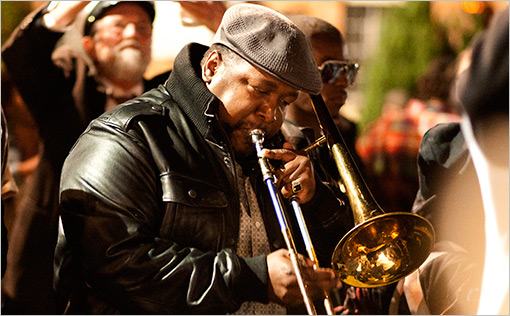The third and last full season of Treme opened last night. You probably didn’t watch it because only about 500,000 people do. If you’re reading this, you should (and if you’re about to say “I don’t get HBO,” that’s very sweet, try googling ‘watch Treme‘). It’s about how to survive disaster and celebrate life, it’s about mutual aid, it’s about how to have difference in urban space. And it’s about the violence, poverty and state-sponsored oppression that is modern America.
Sunday’s premiere opened with a scene all too familiar to any protestor of recent years. A group of musicians assemble outside for a memorial parade to Kerwin James, a trumpeter who died of post-Katrina medical issues in 2007. Before they can move off, a police car descends and arrests those at the front of the line, although musical parades are a long-standing tradition in New Orleans. Antoine (Wendell Pierce) gets arrested as well for flipping off a cop as he walks away. The march reconvenes later with the protection of the National Lawyers Guild green hats, making it clear that the marchers are there on suffrance that the police can revoke at any moment.
Those plot moments aren’t really why you should watch. This is one of the few dramas that’s actually set in a modern America that resembles the U S in which most of us have to live. It does so by depicting complex and imperfect characters, who do the best they can in a society where the odds are stacked against them. It’s a drama where most of the characters are African American–but not gangsters, drug dealers, whores or pimps. It depicts a post-disaster New Orleans–the opening title for series three says simply “Twenty-Five Months After”–but doesn’t blame the people who live there for it.
Here’s the difference with The Wire, also directed by David Simon, which is everyone’s favorite TV show now but was watched by less than a million viewers when broadcast, even in the last series. Now I hear British acquaintances holding forth about the city, even though they cannot identify in which state it is located.The Wire was relentlessly dystopic, presenting Baltimore as a Hobbesian nightmare of what happens when Leviathan no longer rules.
Treme is not a commercial success because it tries to keep multiple stories going in divergent ways. Viewers are expected to be familiar with jump-cuts, serial narration, flash-backs and fragmentary references to local culture. Luckily the New Orleans Times-Picayune publishes a full breakdown of all such references for geeks the next day. The complaint is that the lives we follow “don’t go anywhere.” Where should they go? This is about people staying on, not leaving, continuing to occupy a city that they believe in against all the odds.
If this sounds romantic, and it is, bad things happen to good people in Treme against the usual show-biz logic. Leading characters have committed suicide, one has been murdered and one raped. The last in particular was very hard to watch but I always prefer depictions of the reality of violence, rather than the sanitized cop-show murder. Why is New Orleans the city with the highest murder rate in the country, is the difficult question that Treme asks? Increasingly, it has come to focus on systemic police violence and police corruption in refreshing contrast to the Law And Order exaltation of all law enforcement.
I’m going to suggest that Occupy’s movement of movements is a similar effort to sustain multiple narratives in one overall conversation. Sometimes that conversation breaks down, sometimes you lose the thread, but it’s never less than fascinating. And Treme gives us the metaphor to understand that conversation as American popular music. The New Orleans brass band is a way to have a set of “voices” in conversation at the same moment. By setting that conversation over a funk beat, that conversation takes on an edge–it represents. It represents the popular voices that are not usually heard, outdoors, in public space that is reappropriated for the purpose. (Video below: may not be visible in Chrome)
HBO are cheap about this and post the music videos from the series to iTunes at $1.49 each. So this is the Treme Sidewalk Steppers with the Rebirth Brass Band from 2009, a few months after the setting of the current series. It shows the interaction between brass bands, the Mardi Gras Indians and hip-hop styles. The whole ensemble is about Rebirth, the revival of the flooded city. All our cities are drowning in debt, enmired in violence and swamped with police repression. Step out into the second line.

